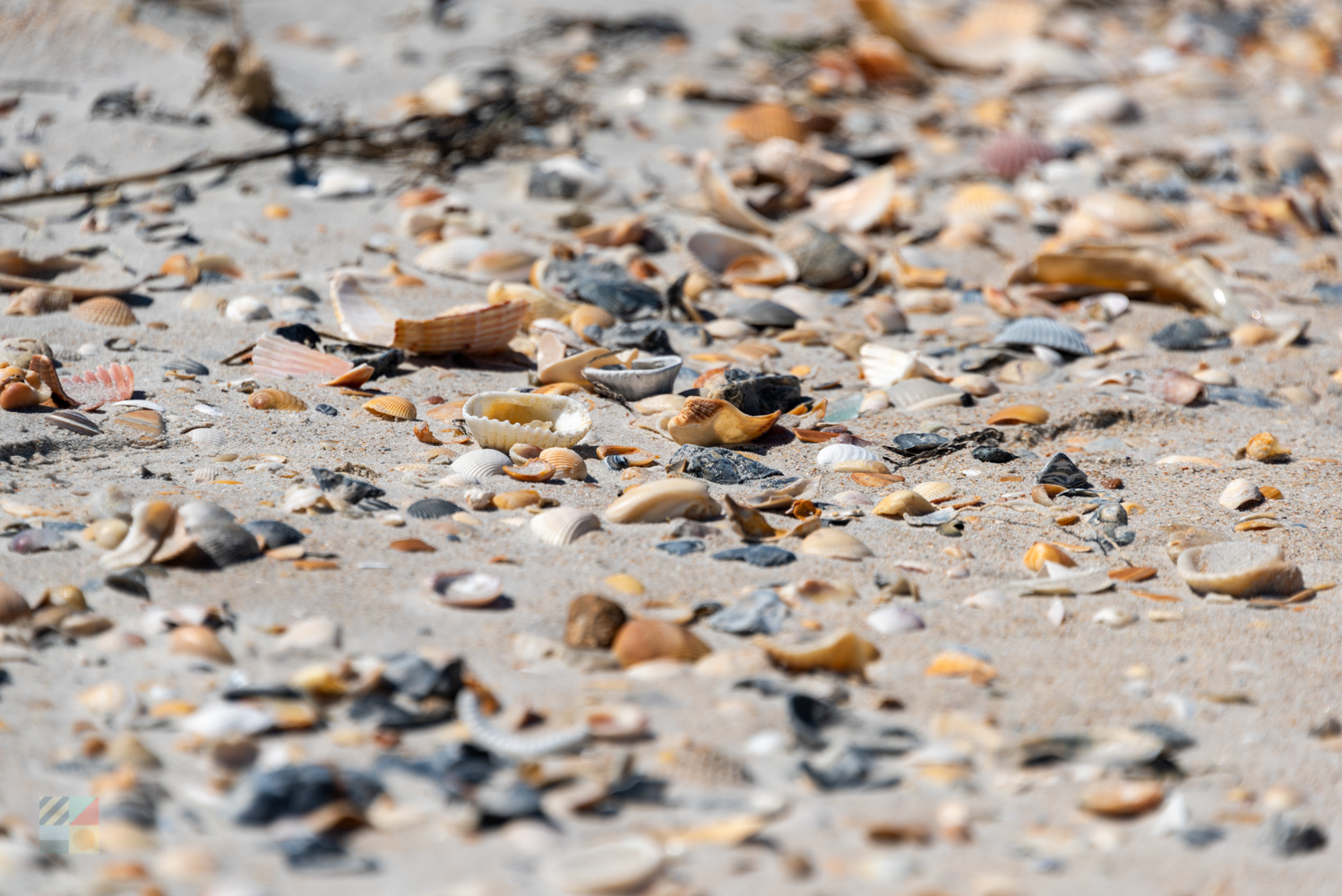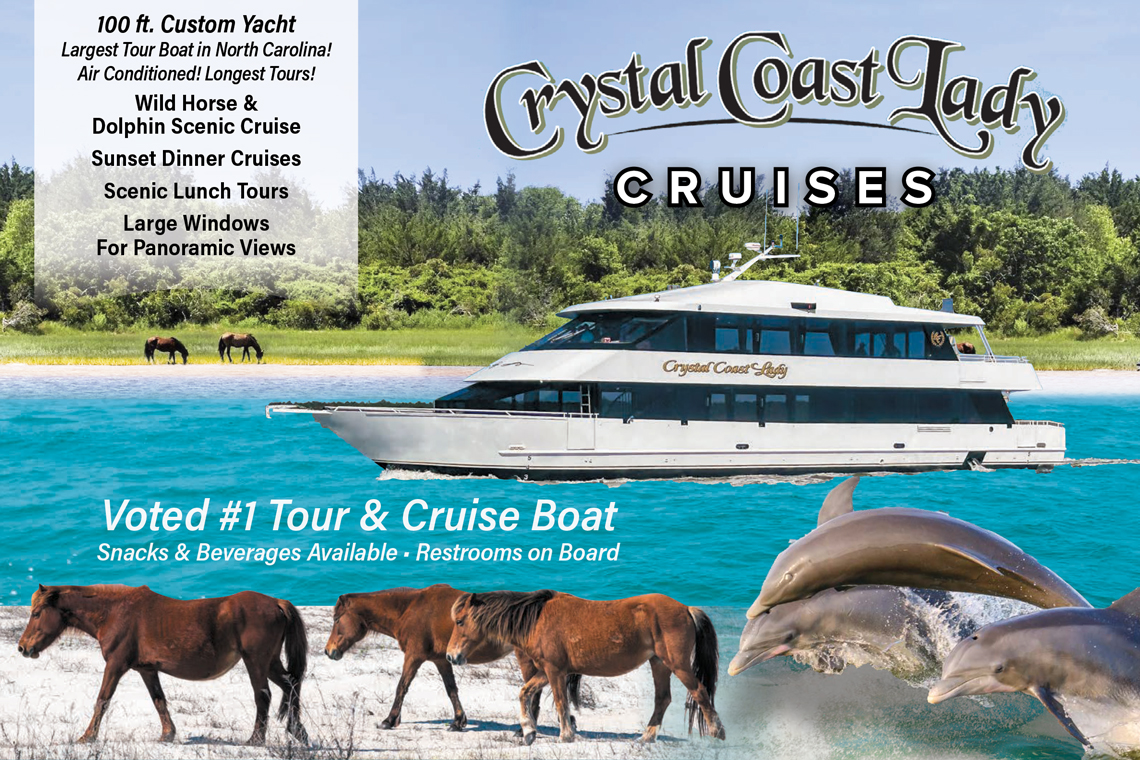Beaufort may be best known as a cool and coastal small town, but a trip to this barely inland community can also easily entail a day at the beach, which means that beachcombers are just a shell’s throw away from a full morning or afternoon of finding an assortment of gems along the seashore.
Close to hopping beach towns like Atlantic Beach, as well as quieter shorelines like the Shackleford Banks where the seashells wash up in waves, Beaufort is a fine starting point for a wide array of shelling adventures that can result in unforgettable, natural souvenirs that vacationers will treasure for years to come.

Where to Go to Find Shells near Beaufort
Though there are no beaches directly within the town limits of Beaufort, visitors will discover that miles and miles of island shoreline are located just a few minutes away via an easy drive, water taxi, or boat ride across the sound. And considering that Beaufort is essentially a central launching point in the heart of the Crystal Coast, beachcombers will find ample options when it comes to where to go to find the best shells along the outlying beaches.
Cape Lookout National Seashore
The 56-mile long Cape Lookout National Seashore is steadily gaining a reputation as a beachcomber’s paradise, and it’s a reputation that is very well deserved. Located just off the coast of Beaufort and Cedar Island, this delicate string of barrier islands is completely undeveloped, with nothing but sand dunes and pristine beaches, which means it’s easy for the shells to wash ashore and remain undiscovered until a lucky beachcomber comes across them. One of the best destinations for shell hunters is “The Point” on the tip of the seashore, just south of the Cape Lookout Lighthouse. This beach which jets out into the Atlantic Ocean is subjected to a wide range of northern and southern currents, which equates to a large variety of shells that regularly wash ashore. It’s a trek to reach this shoreline to be sure, but visitors will be rewarded with piles of finds and little competition from fellow beachcombers.
How to get there from Beaufort: Visitors will want to take the roughly 40-45 minute Island Ferry Service from the Beaufort waterfront, (or the 20 minutes ferry from nearby Harkers Island), to reach the shoreline near the Cape Lookout Lighthouse. From here, beachcombers can walk several miles south, or catch a ride via the makeshift “taxi” on the island, which shuttles visitors to and from the point in the back of a converted pick-up truck.
Shackleford Banks
The Shackleford Banks represent the southernmost part of the Cape Lookout National Seashore, and comprises of an island that’s located just across the sound from the town of Beaufort. Along these undeveloped beaches, visitors can patrol for a wide range of finds that regularly wash ashore with the incoming or outgoing tides. Also isolated, but slightly more crowded than other regions of the Cape Lookout National Seashore, the shelling along this shoreline is excellent, and visitors may also have a run-in with some famed local residents while patrolling the beaches – namely, the Shackleford Banks Wild Horses. Though the beaches are popular in the summer months, spring and fall visitors will enjoy little competition for the good shells, and miles of isolated beaches to peruse.
How to get there from Beaufort: Hop aboard one of the water taxis that depart from the waterfront along Front Street in the heart of Downtown Beaufort. These passenger ferries leave roughly every 15-30 minutes or so during the summertime, and reservations are seldom required (although they are encouraged for visitors who want to ensure they “don’t miss the boat.”) From here, it’s a quick 15-20 minute cruise across Taylor’s Creek and the Back Sound to reach the shoreline, where visitors will typically be dropped off at a central, soundside location.
Atlantic Beach
Atlantic Beach is one of the easiest shelling destinations for Beaufort vacationers to reach, due to its locale that’s just across the causeway from neighboring Morehead City. Known as the easternmost town along the Emerald Isle coastline, this destination can be packed in the summer months, but with a little exploring, beachcombers can often find more desolate shorelines to explore. Head to the Fort Macon State Park, which is located just east of the town limits and which borders the Beaufort Inlet, for the best chances of finding some great coastal treasures. Undeveloped and generally less crowded than the heart of Atlantic Beach, this inlet-bordering shoreline often produces exceptional finds, especially after a storm.
How to get there from Beaufort: Head west to Morehead City and cross the Atlantic Beach Causeway to reach the shoreline in minutes. Once you’ve landed on the beach, bypass The Circle and the other popular beach access points in the center of town, and head east along Fort Macon Road until you reach the Fort Macon State Park. There’s ample parking here, as well as miles of adjacent shoreline that is refreshingly undeveloped, and which borders the ocean, the Bogue Sound, and the Beaufort Inlet.
Rachel Carson Reserve
The Rachel Carson Coastal Estuarine Reserve may be best known for its exceptional birdwatching, hiking trails, and herds of feral horses that were brought to the island in the 1940s, but die-hard beachcombers know that it’s also a decent (and easily accessible) destination for seashells as well. Located just across Taylor’s Creek from the heart of Downtown Beaufort, visitors will find a selection of marshy islands and sandy soundside beaches where it’s not unusual to find marshland-treasures, like moon snails, periwinkles, cockles, and more. Just be sure and check your shells when exploring – it’s not unusual for the seashells in this wild region to be occupied with hermit crabs, snails, and other critters. For the best results, head to the “back side” of the reserve bordering the Back Sound, and wade out a little bit to check the sandy floor where a wide variety of shells can congregate, or be found just beneath the surface.
How to get there from Beaufort: Grab a kayak and launch from the central Lennoxville Road boat ramp, and paddle across Taylor’s Creek to reach the reserve within minutes. Visitors without a kayak or vessel handy can also hop aboard one of the many water taxis along Front Street that access the Rachel Carson Reserve, and can reach the shoreline in roughly 10 minutes or less. From the central boat dock on the Rachel Carson Reserve, stroll to the soundside where tidal-influenced sandy beaches and decent shelling grounds can be found.
Harkers Island
Harkers Island is another hidden gem of a destination along the Crystal Coast shoreline, and it’s a nicely accessible spot from Beaufort, with a location that’s just a 15 minute drive away or so. Once on the island, visitors can head to a small public beach to look for soundside treasures like cockles, scallops, and moon snails, or can hop aboard a ferry at the edge of Harkers Island to reach the Cape Lookout National Seashore. From this destination, paddlers can also launch into the sound waters for a kayak shelling expedition, while everyday sightseers can catch a sunrise or sunset while patrolling the small local beaches. The shelling on Harkers Island itself can be decent, depending on the weather conditions, although the area is most attractive for its easily accessible locale, as well as its inherent small town charm.
How to get there from Beaufort: Drive east along US 70 until you reach Harkers Island Road. From here, visitors can park at the soundside public beach that’s located on the northern terminus of the bridge to Harkers Island, or can keep going until the road ends, and the local passenger ferry docks come into view. For a Cape Lookout National Seashore expedition, climb aboard the ferry and enjoy a quick 20-30 minute cruise across the Core Sound to the Cape Lookout Lighthouse and the adjacent undeveloped shoreline.
How and When to find Shells near Beaufort
Avid beachcombers know that often the conditions have to be just right to acquire the best finds, regardless of where a beach-goer lands. Before you embark on a shelling adventure, try to coincide your trip with these external factors to ensure the best results.
Plan a beach trip on a calm day – High winds and waves can produce broken shells that are covered with a fine layer of sand, making the shells barely visible, and the overall beach conditions rather unpleasant. (Many visitors who go out and explore when it’s very windy report “sand blasting,” which is when the wind-driven sand pummels against the skin.) As such, it’s best to go out to the shoreline when it’s blowing 15 mph or less, to ensure that the shelling conditions are nice and calm.
Plan a beach trip around a tide – Both high and low tides are fine times to acquire shells that are freshly washed ashore, and many beachcombers attest that low tide is optimal, as delicate shells can be found just inches away from the breaking waves. Try to visit the beach up to an hour after a high or a low tide to be the “first” beachcomber to find the new treasures that have just landed on the beach.
Plan a beach trip after a storm – Because hurricanes, tropical storms, and even nor’easters often make long marches up the coastline, they can also bring a far-reaching range of treasures from southern states that don’t typically make an appearance on the North Carolina beaches. Try to plan a last minute getaway a few days after a hurricane to acquire a huge assortment of finds. You’ll want to arrive a couple days after the storm has completely departed the Crystal Coast area, when the ocean waters have calmed down, and the area is seemingly back to normal.
Pay attention to the sand bars and troughs – Beaches that border sandbars, or gently-sloping shorelines where it’s possible to wade out into the ocean for a long time, are usually the beast areas for shells, as they can easily roll along the sand from areas that are well-offshore. In addition, dips or troughs that are found close to shore can have a range of shells as well, that have gotten “stuck” before they made it to the shore. Look for sandbars and dips to indicate areas where great shells may reside, and watch out for rip currents which tend to form close to areas where there are abnormalities along the shoreline.
Varieties of Shells along the Crystal Coast
There are dozens if not hundreds of different types of shells that regularly wash ashore on the beaches that border Beaufort, and new beachcombers will want to look for these popular species that include commonly found treasures, and rare mantle-worthy finds.
Whelks – One of the most prized and surprisingly common finds along the local beaches are whelks, which are readily found along the North Carolina shoreline, and which are commonly mistaken as conchs by newcomers. Although whelks have a similar shape to conchs, with a spiral body that connects with a wide “lip” or opening, whelks are a unique species that come in three distinct varieties. The channel whelk has wide, dull spirals, while the knobbed whelks have a ring of small spikes, and the lightning whelks are almost exactly the same as a knobbed whelk, but with a lip or opening to the left of the shell instead of the right. These shells come in a myriad of different colors, depending on how long they have been in the ocean waters, and can range in size from just 2-3” long to roughly 12” long or more.
Conchs – There are several different types of conch shells that make occasional appearances along the Beaufort-neighboring beaches, and which are all considered rare along the North Carolina shoreline. Beachcombers who want to find one of these rare treasures may stumble upon queen helmet conchs, which are fat, spiraled shells that have a large lip with tiny teeth, Florida Fighting conchs, which are smaller 4-6” copper colored spiral shells with a pink interior, or even tulip conchs, which are slender spiral shells that look like a skinner version of a channel whelk. Any conch is considered a great find as they don’t wash up very often, and they are most likely to appear after a fall hurricane or tropical storm has brushed through the area.
Scotch Bonnets - The Scotch Bonnet is the North Carolina state shell, which is rather surprising considering that it’s a fairly uncommon but treasured find. Known for its fat ridged body, gentle spirals, wide opening with a well-defined lip, and speckled white and brown exterior, this shell is distinctive and considered a fantastic treasure by avid beachcombers. Scotch Bonnets generally measure just 1-4” in length, and are most commonly found on desolate shorelines like the Cape Lookout National Seashore and the Shackleford Banks. Scotch Bonnets can also make an appearance on the soundside beaches, as they are popular temporary residences for hermit crabs that frequent these calmer waters.
Augers, Wentletraps, and Periwinkles – Small spiral shells, like augers, wentletraps, oyster drillers and periwinkles, serve as delicate and prized finds due to their delicate shape and appearance. Generally measuring 1-2” long or even less, these small conch-like shells have small lips and openings, rows of ridges, and a distinctive shape that makes them stand out in a crowd for dedicated beachcombers. Treasure hunters will find these smaller shells in big piles of shells along the beaches, or hiding in small clumps of seaweed. Prized for their appearance as well as their versatility, (they’re commonly used in crafts), these tiny shells are a distinctive part of any North Carolina shell collection.
Olive Shells – The olive shell is one of the more common spiral shell varieties to wash ashore, and is a beautiful find that any beachcomber will treasure. Long, slender and cylindrical, these shells have a short spiral and a large but narrow opening, and typically measure anywhere from 1”- 4” long. “New” olive shells that have freshly washed ashore have brilliant speckled patterns on the exterior, a glossy sheen throughout, and a purple interior that makes them showstoppers in any shelling collection.
Moon Snails – The moon snail is another common spiral find that is distinctive for its fat and perfectly round body, as well as its wide spiral that gets smaller as it winds towards the center of the shell. Also commonly called a “shark eye,” moon snails can grow to be 5” or even 6” big, with fat openings and a heavy and clunky appearance. Moon snails are fairly common finds along the ocean-facing beaches, and are often found in the sound waters as well, as their shape makes them ideal residences for passing hermit crabs.
Sand dollars – Though technically not a shell, sand dollars are another prized find along the shoreline, simply because it’s rare for these delicate species to make it onto the beach intact. Flat and circular, with five delicate ovals seemingly etched into the surface, sand dollars are commonly found along the soundside beaches, and on ocean-facing beaches that are nice and shallow with a gradually sloping shoreline. Beachcombers should note that the bleached white sand dollars are the ones to keep, whereas the brown sand dollars with a fuzzy or spiky appearance are often still alive, and should be tossed back into the water.
Scallops – Scallops are both common and popular finds, due to their classic circle shape with ridges and two fan-like flaps, as well as their wide array of colors that can range from black or solid white, to calico patterns with speckles of red and pink. The colorful varieties are often acquired by beachcombers to use for crafts and other projects, and make exceptional Christmas ornaments or other décor due to their inherent beauty, and relatively smaller size (1” – 3” or so.) Look for scallops everywhere, both in the close-to-shore beaches like the Rachel Carson Coastal Estuarine Reserve and the soundside beaches of Harkers Island, as well as offshore destinations like the Cape Lookout National Seashore.
Cockles, clams, arch shells, razor clams, etc. – These common clam shells are all readily found throughout the beaches that neighbor Beaufort, both along the soundside, along the ocean, and even close to shore. Though relatively common, these versatile shells are nonetheless prized for their simple appearance and versatility – large clam shells make perfect soap dishes, while smaller ones are used by crafty beachcombers as décor or Christmas ornaments. These shells can be found everywhere, and it’s not unusual to find whole clams, (which are great to steam and eat), buried just below the surface in the open sound waters.
Coquinas – Colorful coquinas are found along the ocean shorelines, and are tiny 1” or less clams that are renowned for their rainbow of colors. These small clams are often spotted digging in and out of the low or high tide line along the ocean wash, and can be spotted in the hundreds during the height of summer. Catching a glimpse of hundreds of these colorful clams burrowing into the sand is an amazing sight, and the small delicate shells with a purple interior regularly wash ashore throughout the Cape Lookout National Seashore.
Where to Learn More about Shelling in Beaufort
Beachcombers who are new to the area and want to pick up a few tidbits on the different shells that regularly wash ashore will find ample options for acquiring more information, both in the heart of Beaufort, and at popular spots throughout the Crystal Coast region.
NC Maritime Museum – One of the first stops for Beaufort shell hunters should be the NC Maritime Museum, which has a special room within the museum that’s dedicated entirely to seashells. Featuring more than 1,000 species from roughly 100 countries around the globe, the NC Maritime Museum is a fine destination for identifying shells that are close to home, as well as treasures that hail from exotic locales halfway around the world.
Harkers Island and Cape Lookout Visitors Centers – Head to the ferry docks of nearby Harkers Island, or catch a ferry to the Cape Lookout National Seashore’s Visitors Center next to the Cape Lookout Lighthouse, for a little info on the varying shells that can be found in Beaufort’s backyard. With National Park Service (NPS) rangers on hand to answer questions, as well as a variety of information on the local ecosystems, the NPS visitors centers within or close to the national seashore are a fine destination to acquire more info on what to expect when shelling along the barrier island shorelines.
Beaufort NC Bookstores and Gift Shops – Downtown Beaufort is renowned for its collection of gift stores and nautical-themed boutiques, and these sites are ideal destinations to pick up a shelling guide or two that focuses on the local waters. From laminated maps and pamphlets that outline common species, to in-depth field guides with images of all the common and not-so-common finds, a NC shelling guide is a must for any visitor who wants to learn more about the shells that frequent the local shorelines.
Tips and Tricks for Shelling Near Beaufort
New to the area? Book a tour – A number of shelling cruises and tours depart from the Beaufort waterfront, and a shelling cruise is an exceptional way for newcomers to ensure they access the best beaches and the best finds.
Be an early bird – Book the first boat that departs Downtown Beaufort or Harkers Island, or take a drive to Atlantic Beach around sunrise to be the “first” beachcomber to hit the sand. The first folks on the beach often acquire the best finds that may have washed up overnight.
Search smarter along the beaches – Shell seekers who are visiting a popular beach may find shells that the other throngs of beachcombers have missed by thinking outside the box. Look under clumps of seaweed, where delicate shells may hide, or wade in the water to find shells that are close to the sand, but which haven’t quite made it ashore yet.
Come prepared – especially on the National Seashore! – The Cape Lookout National Seashore is renowned for exceptional shelling simply because it is so isolated. Be sure and bring along plenty of water, snacks, and multiple bags to both haul your finds, and to dispose of any trash along the way. The beaches are stunning, but there are very few amenities on these islands – which includes trash cans, water, and even restrooms.
Double check your shells for local residents – Many shells along the soundside are already occupied by snails or hermit crabs, so be sure and check your shells for any “residents.”
Climb aboard for the best results – One of the best attractions of Beaufort is the town’s assortment of ferry services, water taxis, and cruises, and the best way to find shells is to climb aboard and start exploring. The Shackleford Banks and the beaches around Cape Lookout are both renowned as the best shelling destinations in the area, and both can be easily reached by simply booking a trek across the sound.
The shelling near Beaufort is nothing short of outstanding, which is why many vacationers reserve a morning, afternoon, or a full day or two to make an exploration of the adjacent beaches. With a wide array of species – which includes a number of rare and coveted finds – it’s easy to pick up a few coastal treasures that will serve as a reminder of your vacation for years to come.






